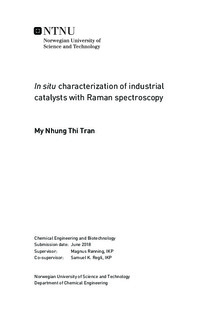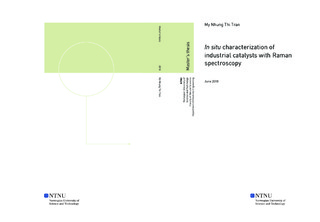| dc.description.abstract | Raman spectroscopy is one of the most powerful characterization methods for in situ Raman study of catalytic materials and surfaces under working conditions. The use of Raman spectroscopy in catalytic NO oxidation would be of interest, as it provides fundamental information about catalytic molecular structures of the active phase and surface reaction intermediates. The platinum metal supported oxides catalyst are found to be the most active in NO oxidation, as they have an outstanding activity over a range of conditions.
Herein, a systematic work was performed to study the advanced characterization method, in situ Raman Spectroscopy by characterization of active platinum based catalysts for NO oxidation. Two supported metal oxides catalyst, 5wt.% Pt/Al2O3 and 5wt.% Pt/ZrO2, were synthesized by one step aqueous incipient wetness impregnation. Catalysts were characterized by nitrogen adsorption, X-Ray diffraction (XRD), CO chemisorption and temperature programmed reduction (TPR). The catalysts have furthermore been investigated by ex situ Raman spectroscopy at ambient conditions and in situ Raman spectroscopy at industrially relevant conditions in terms of temperature at atmospheric pressure under different atmospheres (O2, H2, Ar).
The characterization techniques indicated that the catalysts contained both small and large particles detected by CO chemisorption and XRD, respectively. Both Pt and PtO2 were identified, but due to the low metal loading, the associated Raman band could not be detected. However, a Raman band located at 577 cm-1 attributed to a Pt-O stretch, was identified in the Raman spectra of 5wt.% Pt/Al2O3, but due to the complications with the in situ cell window the experiment could not be further carried out. It is, therefore, recommended to try more suitable in situ cell windows to optimize the Raman signals.
Ex situ Raman measurements were well established to gain a better understanding of the principle of Raman spectroscopy and Raman parameters. A quite complex in situ Raman spectroscopic characterization procedure of 5wt.% Pt/ZrO2 under certain reaction conditions was successfully carried out using a quartz in situ cell window. However, this could be adapted to some other materials which can be more Raman active. | |

